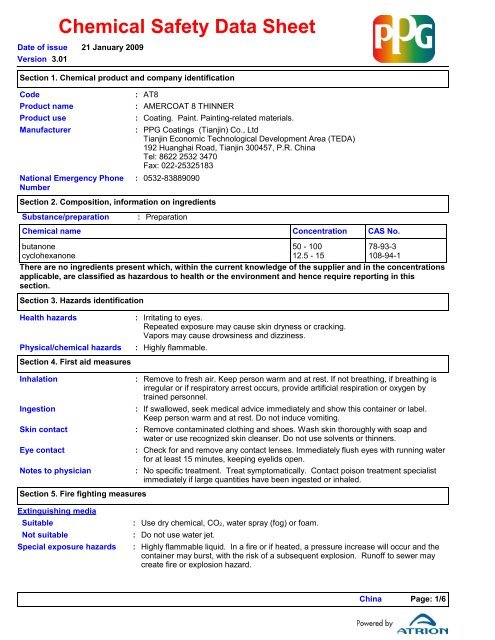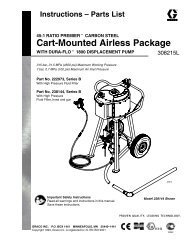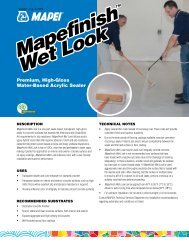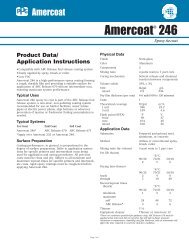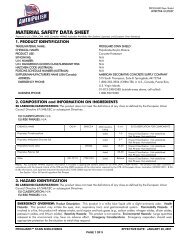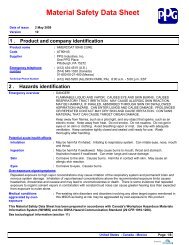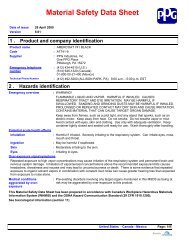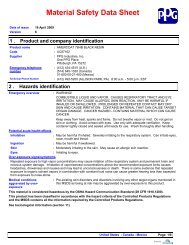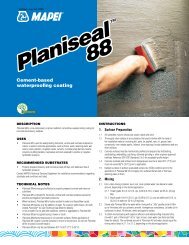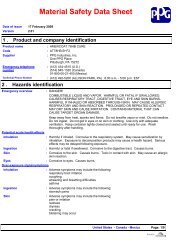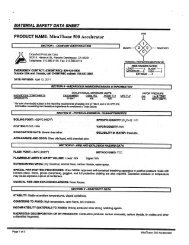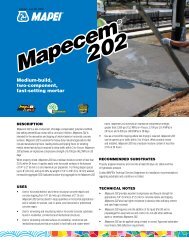Amercoat 8 - MSDS - AltaPaints and Coatings
Amercoat 8 - MSDS - AltaPaints and Coatings
Amercoat 8 - MSDS - AltaPaints and Coatings
Create successful ePaper yourself
Turn your PDF publications into a flip-book with our unique Google optimized e-Paper software.
Chemical Safety Data SheetDate of issue 21 January 2009Version 3.01Section 1. Chemical product <strong>and</strong> company identificationCodeProduct nameProduct useManufacturerNational Emergency PhoneNumber: AT8: AMERCOAT 8 THINNER: Coating. Paint. Painting-related materials.:PPG <strong>Coatings</strong> (Tianjin) Co., LtdTianjin Economic Technological Development Area (TEDA)192 Huanghai Road, Tianjin 300457, P.R. ChinaTel: 8622 2532 3470Fax: 022-25325183: 0532-83889090Section 2. Composition, information on ingredientsSubstance/preparation: PreparationChemical nameConcentrationCAS No.butanone 50 - 100 78-93-3cyclohexanone 12.5 - 15 108-94-1There are no ingredients present which, within the current knowledge of the supplier <strong>and</strong> in the concentrationsapplicable, are classified as hazardous to health or the environment <strong>and</strong> hence require reporting in thissection.Section 3. Hazards identificationHealth hazardsPhysical/chemical hazards ::Irritating to eyes.Repeated exposure may cause skin dryness or cracking.Vapors may cause drowsiness <strong>and</strong> dizziness.Highly flammable.Section 4. First aid measuresInhalationIngestionSkin contactEye contactNotes to physician:::::Remove to fresh air. Keep person warm <strong>and</strong> at rest. If not breathing, if breathing isirregular or if respiratory arrest occurs, provide artificial respiration or oxygen bytrained personnel.If swallowed, seek medical advice immediately <strong>and</strong> show this container or label.Keep person warm <strong>and</strong> at rest. Do not induce vomiting.Remove contaminated clothing <strong>and</strong> shoes. Wash skin thoroughly with soap <strong>and</strong>water or use recognized skin cleanser. Do not use solvents or thinners.Check for <strong>and</strong> remove any contact lenses. Immediately flush eyes with running waterfor at least 15 minutes, keeping eyelids open.No specific treatment. Treat symptomatically. Contact poison treatment specialistimmediately if large quantities have been ingested or inhaled.Section 5. Fire fighting measuresExtinguishing mediaSuitable :Not suitable :Special exposure hazards :Use dry chemical, CO2, water spray (fog) or foam.Do not use water jet.Highly flammable liquid. In a fire or if heated, a pressure increase will occur <strong>and</strong> thecontainer may burst, with the risk of a subsequent explosion. Runoff to sewer maycreate fire or explosion hazard.ChinaPage: 1/6
Product code AT8Product name AMERCOAT 8 THINNERHazardous combustionproductsSpecial protectiveequipment for fire-fighters::Date of issue 21 January 2009 Version 3.01Promptly isolate the scene by removing all persons from the vicinity of the incident ifthere is a fire. No action shall be taken involving any personal risk or without suitabletraining. Move containers from fire area if this can be done without risk. Use waterspray to keep fire-exposed containers cool.Decomposition products may include the following materials:carbon oxidesFire-fighters should wear appropriate protective equipment <strong>and</strong> self-containedbreathing apparatus (SCBA) with a full face-piece operated in positive pressuremode.Section 6. Accidental release measuresPersonal precautionsEnvironmental precautionsLarge spill :Small spillSection 7. H<strong>and</strong>ling <strong>and</strong> storage: No action shall be taken involving any personal risk or without suitable training.Evacuate surrounding areas. Keep unnecessary <strong>and</strong> unprotected personnel fromentering. Do not touch or walk through spilled material. Shut off all ignition sources.No flares, smoking or flames in hazard area. Avoid breathing vapor or mist. Provideadequate ventilation. Wear appropriate respirator when ventilation is inadequate.Put on appropriate personal protective equipment (see section 8).:Avoid dispersal of spilled material <strong>and</strong> runoff <strong>and</strong> contact with soil, waterways, drains<strong>and</strong> sewers. Inform the relevant authorities if the product has caused environmentalpollution (sewers, waterways, soil or air).Stop leak if without risk. Move containers from spill area. Approach release fromupwind. Prevent entry into sewers, water courses, basements or confined areas.Wash spillages into an effluent treatment plant or proceed as follows. Contain <strong>and</strong>collect spillage with non-combustible, absorbent material e.g. s<strong>and</strong>, earth, vermiculiteor diatomaceous earth <strong>and</strong> place in container for disposal according to localregulations (see section 13). Use spark-proof tools <strong>and</strong> explosion-proof equipment.Dispose of via a licensed waste disposal contractor. Contaminated absorbentmaterial may pose the same hazard as the spilled product. Note: see section 1 foremergency contact information <strong>and</strong> section 13 for waste disposal.: Stop leak if without risk. Move containers from spill area. Dilute with water <strong>and</strong> mopup if water-soluble or absorb with an inert dry material <strong>and</strong> place in an appropriatewaste disposal container. Use spark-proof tools <strong>and</strong> explosion-proof equipment.Dispose of via a licensed waste disposal contractor.H<strong>and</strong>ling:Put on appropriate personal protective equipment (see section 8). Use only withadequate ventilation. Wear appropriate respirator when ventilation is inadequate.Use explosion-proof electrical (ventilating, lighting <strong>and</strong> material h<strong>and</strong>ling) equipment.Eating, drinking <strong>and</strong> smoking should be prohibited in areas where this material ish<strong>and</strong>led, stored <strong>and</strong> processed. Workers should wash h<strong>and</strong>s <strong>and</strong> face beforeeating, drinking <strong>and</strong> smoking. Do not breathe vapor or mist. Do not ingest. Avoidcontact with eyes, skin <strong>and</strong> clothing. Do not enter storage areas <strong>and</strong> confinedspaces unless adequately ventilated. Keep in the original container or an approvedalternative made from a compatible material, kept tightly closed when not in use.Store <strong>and</strong> use away from heat, sparks, open flame or any other ignition source. Usenon-sparking tools. Take precautionary measures against electrostatic discharges.To avoid fire or explosion, dissipate static electricity during transfer by grounding <strong>and</strong>bonding containers <strong>and</strong> equipment before transferring material. Empty containersretain product residue <strong>and</strong> can be hazardous. Do not reuse container.ChinaPage: 2/6
Product code AT8Product name AMERCOAT 8 THINNERStorageSection 8. Exposure controls/personal protectionChemical name:Date of issue 21 January 2009 Version 3.01Store in accordance with local regulations. Store in a segregated <strong>and</strong> approvedarea. Store in original container protected from direct sunlight in a dry, cool <strong>and</strong> wellventilatedarea, away from incompatible materials (see section 10) <strong>and</strong> food <strong>and</strong>drink. Eliminate all ignition sources. Separate from oxidizing materials. Keepcontainer tightly closed <strong>and</strong> sealed until ready for use. Containers that have beenopened must be carefully resealed <strong>and</strong> kept upright to prevent leakage. Do not storein unlabeled containers. Use appropriate containment to avoid environmentalcontamination.Exposure limitsbutanone GBZ-2 (China, 8/2007).PC-STEL: 600 mg/m³, 0 times per shift, 15minute(s).PC-TWA: 300 mg/m³, 0 times per shift, 8hour(s).cyclohexanoneGBZ-2 (China, 8/2007). Absorbed throughskin.PC-TWA: 50 mg/m³, 0 times per shift, 8hour(s).Recommended monitoringproceduresExposure controlsOccupational exposurecontrolsHygiene measures :Eye protectionH<strong>and</strong> protectionGloves:::If this product contains ingredients with exposure limits, personal, workplaceatmosphere or biological monitoring may be required to determine the effectivenessof the ventilation or other control measures <strong>and</strong>/or the necessity to use respiratoryprotective equipment. Reference should be made to European St<strong>and</strong>ard EN 689 formethods for the assessment of exposure by inhalation to chemical agents <strong>and</strong>national guidance documents for methods for the determination of hazardoussubstances.: Use only with adequate ventilation. Use process enclosures, local exhaustventilation or other engineering controls to keep worker exposure to airbornecontaminants below any recommended or statutory limits. The engineering controlsalso need to keep gas, vapor or dust concentrations below any lower explosivelimits. Use explosion-proof ventilation equipment.Wash h<strong>and</strong>s, forearms <strong>and</strong> face thoroughly after h<strong>and</strong>ling chemical products, beforeeating, smoking <strong>and</strong> using the lavatory <strong>and</strong> at the end of the working period.Appropriate techniques should be used to remove potentially contaminated clothing.Wash contaminated clothing before reusing. Ensure that eyewash stations <strong>and</strong>safety showers are close to the workstation location.Chemical splash goggles.Chemical-resistant, impervious gloves complying with an approved st<strong>and</strong>ard shouldbe worn at all times when h<strong>and</strong>ling chemical products if a risk assessment indicatesthis is necessary.: For prolonged or repeated h<strong>and</strong>ling, use the following type of gloves:Respiratory protection :Skin protection:Recommended: foilIf workers are exposed to concentrations above the exposure limit, they must useappropriate, certified respirators. Use a properly fitted, air-purifying or air-fedrespirator complying with an approved st<strong>and</strong>ard if a risk assessment indicates this isnecessary. Respirator selection must be based on known or anticipated exposurelevels, the hazards of the product <strong>and</strong> the safe working limits of the selectedrespirator.Personal protective equipment for the body should be selected based on the taskbeing performed <strong>and</strong> the risks involved <strong>and</strong> should be approved by a specialistbefore h<strong>and</strong>ling this product.ChinaPage: 3/6
Product code AT8Product name AMERCOAT 8 THINNEREnvironmental exposurecontrolsSection 9. Physical <strong>and</strong> chemical propertiesPhysical stateBoiling pointVapor pressureRelative density : 0.82Flash pointExplosion limitsViscosityEvaporation rate (butylacetate = 1)VolatilityMaterial supportscombustion.Section 10. Stability <strong>and</strong> reactivityDate of issue 21 January 2009 Version 3.01: Emissions from ventilation or work process equipment should be checked to ensurethey comply with the requirements of environmental protection legislation. In somecases, fume scrubbers, filters or engineering modifications to the process equipmentwill be necessary to reduce emissions to acceptable levels.:::::::::Liquid.>37.78°C (>100°F)8.5 kPa (63.7 mm Hg)Closed cup: -6.67°C (20°F)Lower: 1.8%Kinematic (40°C (104°F)):
Product code AT8Product name AMERCOAT 8 THINNERDate of issue 21 January 2009 Version 3.01Section 12. Ecological informationEnvironmental effectsMobilityOther adverse effects: No known significant effects or critical hazards.: Not available.: No known significant effects or critical hazards.Do not allow to enter drains or watercourses.Section 13. Disposal considerationsWaste disposal :The generation of waste should be avoided or minimized wherever possible. Emptycontainers or liners may retain some product residues. This material <strong>and</strong> itscontainer must be disposed of in a safe way. Dispose of surplus <strong>and</strong> non-recyclableproducts via a licensed waste disposal contractor. Disposal of this product, solutions<strong>and</strong> any by-products should at all times comply with the requirements ofenvironmental protection <strong>and</strong> waste disposal legislation <strong>and</strong> any regional localauthority requirements. Avoid dispersal of spilled material <strong>and</strong> runoff <strong>and</strong> contactwith soil, waterways, drains <strong>and</strong> sewers.Empty containers or liners may retain some product residues. This material <strong>and</strong> itscontainer must be disposed of in a safe way.The classification of the product may meet the criteria for a hazardous waste.Disposal should be inaccordance with applicable regional, national <strong>and</strong> local laws <strong>and</strong> regulations.Refer to Section 7: HANDLING AND STORAGE <strong>and</strong> Section 8: EXPOSURE CONTROLS/PERSONALPROTECTION for additional h<strong>and</strong>ling information <strong>and</strong> protection of employees. Section 6. Accidental releasemeasuresSection 14. Transport informationUN numberProper shipping namePackage markPacking group: 1263: PAINT RELATED MATERIAL: 3: IISection 15. Regulatory informationChina inventory (IECSC)Australia inventory (AICS)Canada inventoryEurope inventoryJapan inventory (ENCS)Korea inventory (KECI)Philippines inventory(PICCS)United States inventory(TSCA 8b): All components are listed or exempted.: All components are listed or exempted.: All components are listed or exempted.: All components are listed or exempted.: All components are listed or exempted.: All components are listed or exempted.: All components are listed or exempted.: All components are listed or exempted.Authored with regard to:- "Classification <strong>and</strong> Mark for commonly used dangerous chemicals" (GB13690-1992)- "General rules for preparation of a Chemical Safety Data Sheet" (GB16483-2000)- "The principle of classification of transport packaging groups of dangerous goods" (GB/T15098-94)- "Classification <strong>and</strong> code of dangerous goods" (GB6944-2005)ChinaPage: 5/6
Product code AT8Product name AMERCOAT 8 THINNERDate of issue 21 January 2009 Version 3.01Section 16. Other informationDate of printing : 1/21/2009.Prepared by EHSVerified by EHSIndicates information that has changed from previously issued version.Notice to readerThe information contained in this data sheet is based on present scientific <strong>and</strong> technical knowledge. The purpose ofthis information is to draw attention to the health <strong>and</strong> safety aspects concerning the products supplied by PPG, <strong>and</strong> torecommend precautionary measures for the storage <strong>and</strong> h<strong>and</strong>ling of the products. No warranty or guarantee is given inrespect of the properties of the products. No liability can be accepted for any failure to observe the precautionarymeasures described in this data sheet or for any misuse of the products.ChinaPage: 6/6


